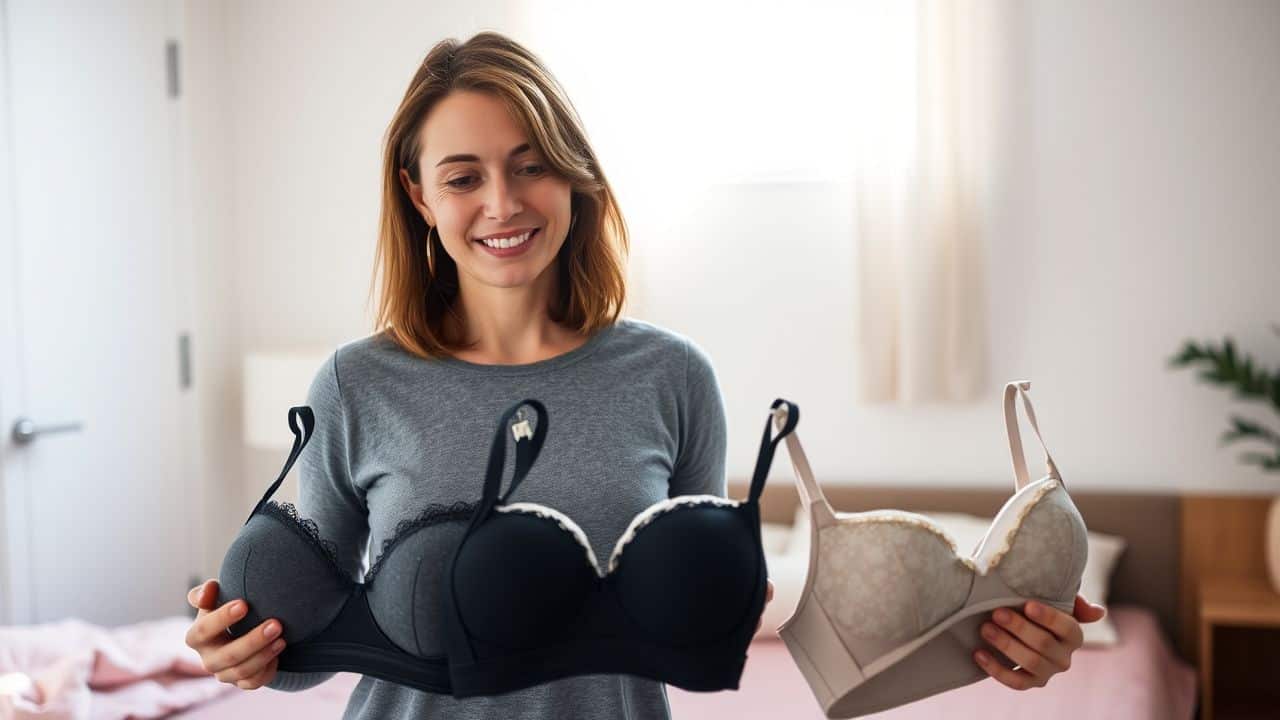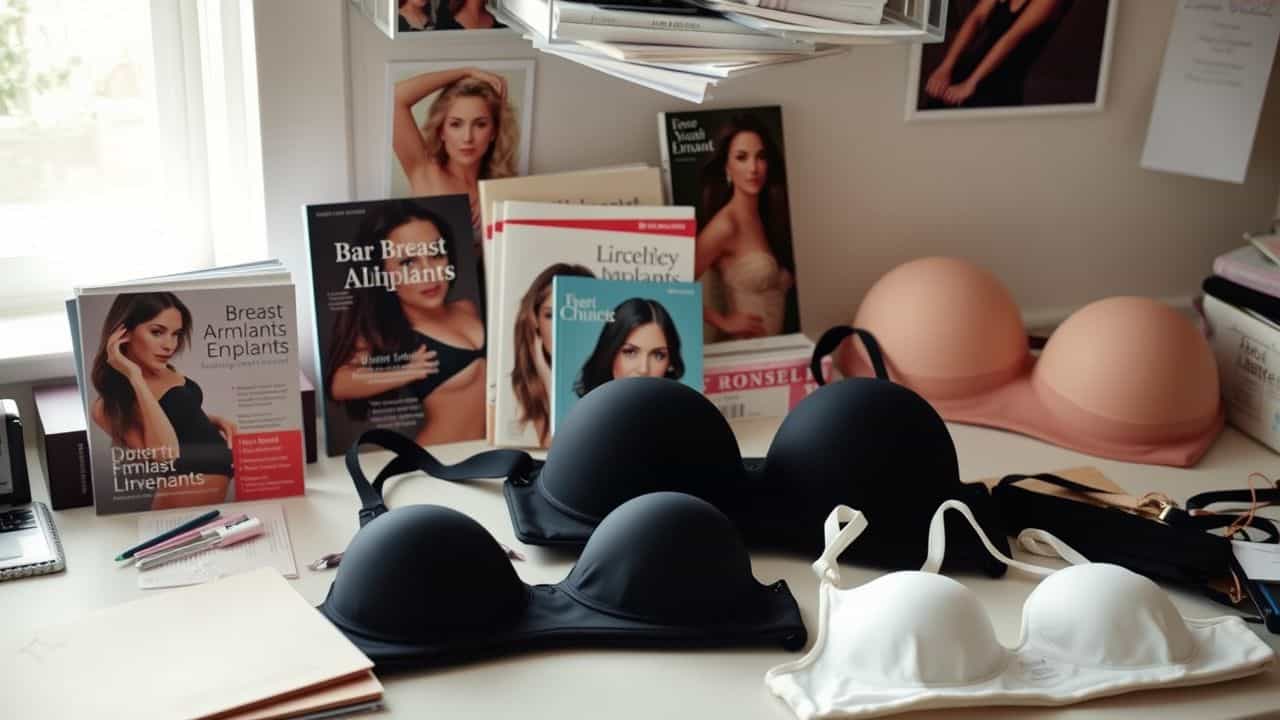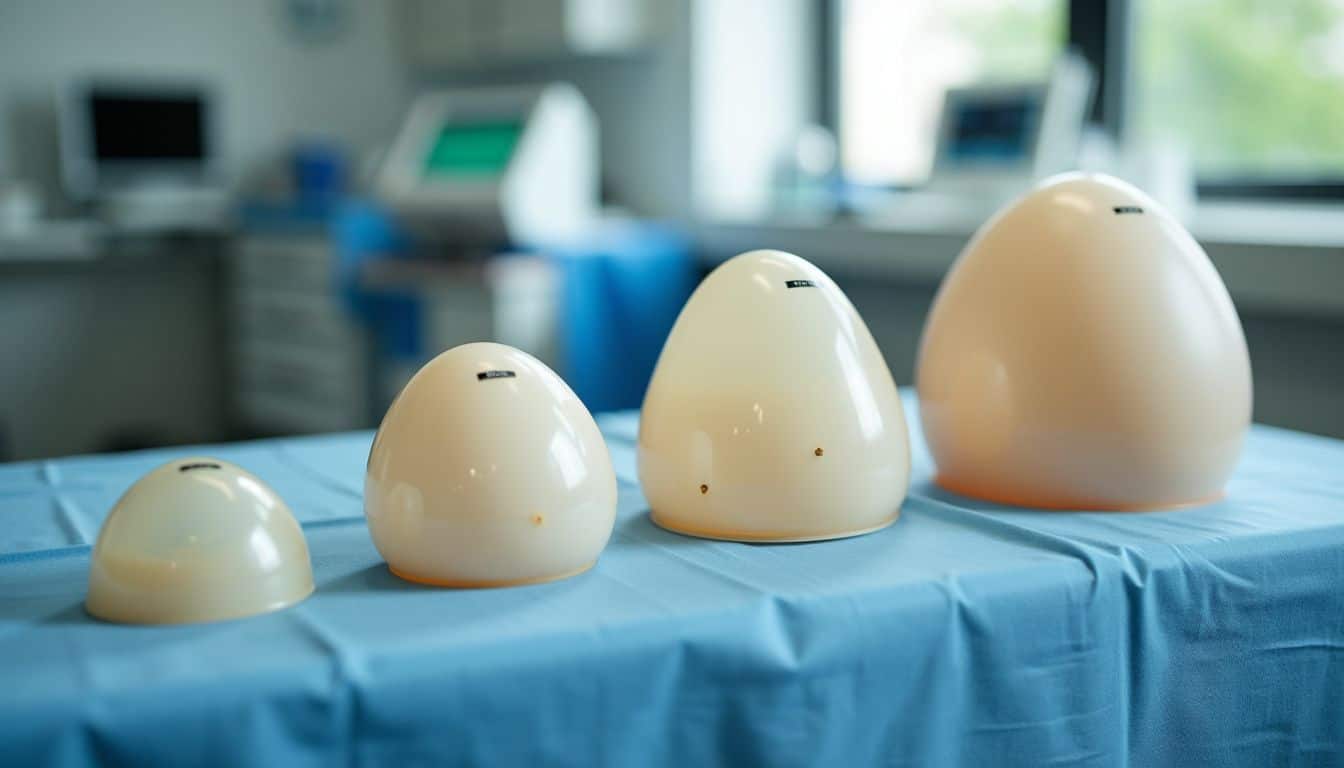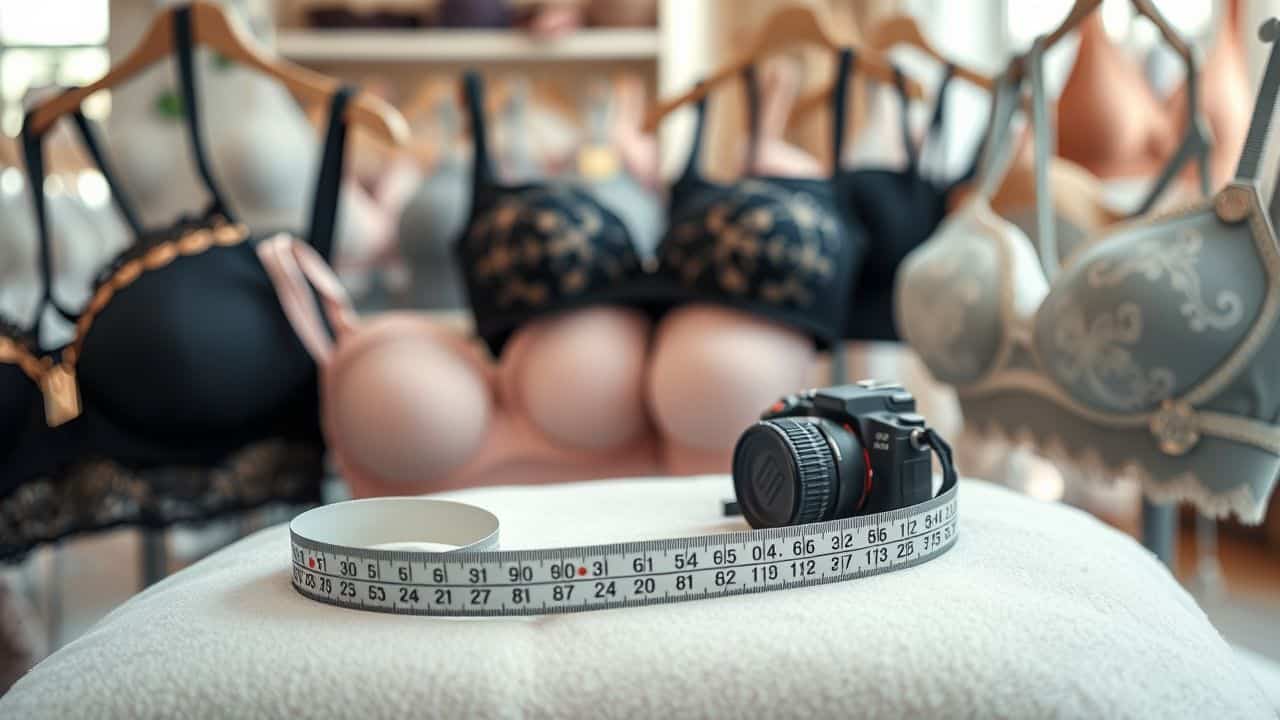Ever wondered, “What do C cup breasts look like?” You’re not alone. Many women ponder this question when considering breast augmentation. Did you know C cups are one of the most requested sizes in cosmetic surgery? This article will unveil six surprising facts about C cup breasts.
Get ready for some eye-opening insights!
Key Takeaways
C cup breasts are often described as the “Goldilocks” size – not too big or small. They typically measure 3–4 inches out from the chest wall and create subtle cleavage.
Breast implants for C cups usually range from 300-350 cc in volume. Fat transfer is a natural alternative that can increase size by 1-2 cup sizes.
Genetics, weight changes, and hormones all influence breast size. Losing or gaining 20–50 pounds can shift cup size significantly.
To measure for a C cup, subtract band size from bust measurement. A 3-inch difference indicates a C cup.
Breast augmentation surgery carries risks like infection and implant rupture. Over 1% of patients face local complications.
Table of Contents
Exploring C Cup Size

C cups are a popular breast size that many women desire. They’re not too big, not too small – just right for many body types. Let’s dive into what makes C cups special and how they compare to other sizes.
Visual Characteristics of C Cups

C cup breasts offer a balanced, natural look. They’re not too big, not too small – just right for many women. Picture a gentle slope from the collarbone to the nipple. The breast fills a hand comfortably, with a nice roundness.
Most C cups don’t sag much, keeping their shape well in and out of a bra.
C cups are like the Goldilocks of breast sizes – not too big, not too small, but just right.
These breasts typically measure about 3–4 inches out from the chest wall. They create a subtle cleavage in most tops without being overly showy. C cups often look great in both fitted and loose clothing, giving women lots of style options.
Their moderate size means they’re less likely to cause back pain or posture issues than larger cup sizes.
Comparison with Other Breast Sizes

C cups sit comfortably in the middle of the breast size spectrum. They offer a balanced look that many women find appealing. Let’s compare C cups to other sizes:
| Cup Size | Comparison to C Cup |
|---|---|
| A Cup | Smaller, less projection. Often described as “sporty”. |
| B Cup | Slightly smaller. Natural-looking but less noticeable. |
| C Cup | The “Goldilocks” size. Not too big, not too small. |
| D Cup | Larger, more prominent. Compared to D cup breasts, C cups are more subtle. |
| DD Cup and Beyond | Much fuller, can cause back pain for some women. |
I’ve chatted with many women about their breast sizes. C cups often get praised for their versatility. They look great in most outfits without being overwhelming. One friend told me, “My C cups are just right – I can go braless or rock a push-up bra for extra oomph.”
Cup size alone doesn’t tell the whole story. Band size matters too. A 32C looks different from a 38C. And breast shape varies widely. Some C cups are perky, others fuller at the bottom.
Ultimately, there’s no “perfect” size. What matters most is how you feel in your own skin. Whether you’re rocking an A cup or double Ds, confidence is the sexiest accessory of all.
Achieving C Cup Breasts

Want C cup breasts? You’ve got options. From implants to fat transfer, there’s a way to get the look you’re after.
Breast Augmentation Using Implants

Breast implants offer a popular way to achieve C cup breasts. Many women choose this option to enhance their figure and boost confidence.
- Implant types: Silicone gel and saline implants are common choices. Silicone feels more natural, while saline is adjustable after surgery.
- Implant size: For a C cup, surgeons often use 300 to 350 cc implants. This volume typically increases breast size by one to 1.5 cup sizes.
- Surgical process: The procedure takes 1–2 hours under general anesthesia. Surgeons make small cuts to insert the implants.
- Recovery time: Most women return to work within a week. Full recovery takes about 6–8 weeks.
- Cost: The average surgeon’s fee is around $4,294. This doesn’t include anesthesia, hospital fees, or aftercare.
- Results: Implants can last 10–15 years. Regular check-ups help spot any issues early.
- Risks: Like all surgeries, there are potential complications. These may include infection, scarring, or implant rupture.
- Customization: Surgeons can tailor the implant shape, size, and placement to fit your body and goals.
Enhance with Fat Transfer
Fat transfer offers a natural way to boost breast size. This method uses your own body fat to enhance your curves.
- Liposuction harvest: Doctors remove fat from areas like your thighs or belly.
- Fat processing: The harvested fat gets cleaned and prepared for injection.
- Breast injection: Your surgeon carefully injects the fat into your breasts.
- Size increase: You can expect to go up one or two cup sizes.
- Natural look and feel: The results often look and feel more natural than implants.
- Recovery time: Most women need about two weeks of downtime.
- Surgical bra: You’ll wear a special bra to support healing for several weeks.
- Pain management: Over-the-counter meds usually handle any discomfort.
- Swelling: Expect some puffiness for a few weeks after surgery.
- Long-lasting results: With proper care, results can last for years.
- Dual benefits: You slim down problem areas while boosting your bust.
- Low risk: Since it’s your own fat, there’s less chance of rejection.
Now, let’s explore the factors that influence breast size and shape.
Options for a Breast Lift
Breast lifts give women a chance to bring back perkiness and shape to their chests. Here are some popular options for this change-making procedure.
- Traditional breast lift: This method takes away extra skin and reshapes breast tissue. Doctors make cuts around the areola, down to the breast crease, and along the crease. It’s great for major sagging.
- Crescent lift: A small cut is made along the top half of the areola. It’s best for minor sagging and can be done with breast implants.
- Donut lift: Cuts circle the areola. This works well for mild to moderate sagging and can make the areola smaller.
- Lollipop lift: Cuts go around the areola and straight down to the breast crease. It’s good for moderate sagging and gives nice shaping.
- Internal bra technique: This uses special threads or mesh to create an inner support system. It can give results that last longer.
- Fat grafting with lift: Your own fat is moved from other body areas to your breasts. This adds volume while lifting.
- Laser bra lift: A laser creates internal support using your own tissue. It may lead to less scarring and results that last longer.
- Non-surgical options: These include radiofrequency treatments or ultrasound. They offer mild lifting with no cuts but results vary.
Results take months to fully show. Talk to a board-certified plastic surgeon to find your best option.
Reducing Larger Breasts to C Cup

Many women seek breast reduction to achieve a C cup size. This surgery can ease back pain and boost confidence.
- Consultation: Meet with a board-certified plastic surgeon to discuss your goals. They’ll assess your breast tissue and overall health.
- Imaging: Vectra 3D imaging helps visualize potential results. It’s a cool tech tool that shows how you might look post-op.
- Technique: Surgeons often use the “anchor” or “lollipop” incision. These methods remove excess fat, glandular tissue, and skin.
- Recovery: Expect 2–6 weeks of downtime. You’ll wear a special bra and limit arm movements at first.
- Results: Most women report high satisfaction rates. A 2019 study found 95% of patients were happy with their new C cups.
- Bra shopping: Get fitted professionally after healing. Over 70% of women wear the wrong size bra – don’t be one of them!
- Long-term care: Regular check-ups and mammograms are key. Your doc will guide you on the best screening schedule.
Next, let’s explore how to measure for the perfect C cup fit.
Factors That Influence Breast Size

Genetics, weight, and hormones play a big role in shaping your bust. Curious about how these factors affect your chest? Keep reading to learn more!
Genetic Impact on Breast Size
Genes play a big role in breast size. A study by 23andMe found seven genetic factors linked to how big breasts are. These genes affect things like fat storage and hormone levels. It’s not just one gene, but a mix of many that shape breast size.
Some of these genes also tie into breast cancer risk, showing a complex link between size and health.
Your DNA is like a blueprint for your body, including your breasts. But it’s not set in stone. Things like weight, age, and hormones can change breast size over time. Next, let’s look at how weight impacts breast size.
Our genes are the starting point, but life writes the rest of the story.
How Weight Changes Affect Breast Size
Weight changes can really shake up your breast size. Losing or gaining 20–50 pounds often leads to cup size shifts. Your breasts are partly made of fat, so they shrink when you slim down and grow when you bulk up.
But it’s not that simple. Dense breast tissue doesn’t change much with weight. So if you’ve got mostly dense tissue, your cup size might stay put even as the scale moves.
Yo-yo dieting is tough on your girls. It stretches and shrinks the skin over and over. This can leave your breasts looking saggy or less perky. The skin loses its snap, like an old rubber band.
It’s not just about looks, though. These changes can make finding a comfy bra harder. Next up, let’s talk about how hormones play a role in breast size.
Hormonal Influence on Breasts
Hormones play a big role in breast size and shape. Estrogen and progesterone are the main players here. They make breasts grow during puberty and pregnancy. Higher progesterone levels can even boost breast tissue activity.
But it’s not all about growth – hormones can shrink breasts too. After menopause, when estrogen drops, breasts often get smaller and less firm. Interestingly, stress indirectly reduces breast size by messing with hormone levels.
Your monthly cycle also affects your breasts. They might feel fuller or more tender at certain times. This is due to hormone shifts. Irregular periods can impact breast tissue too.
Studies show they’re linked to lower breast activity and higher FSH and LH levels. Age is another factor – there’s a slight dip in breast tissue activity as we get older. Next up, let’s talk about how to measure for the right C cup size.
Measuring for the Right C Cup

Getting the right C cup fit is key. It’s not just about looks – comfort matters too!
Correct Techniques for Measuring Cup Size
Getting the right cup size is crucial for comfort and support. Let’s dive into the correct techniques for measuring your cup size.
- Start with a soft measuring tape. Wrap it snugly around your ribcage, just under your bust. This gives you your band size.
- Next, measure around the fullest part of your bust. Keep the tape level and don’t pull too tight.
- Subtract your band size from your bust measurement. Each inch difference equals one cup size.
- A 1-inch difference is an A cup, 2 inches a B cup, and 3 inches a C cup. This pattern continues for larger sizes.
- Try on bras in your calculated size. The band should be snug but not tight. Your breasts should fill the cups without spillage or gaping.
- Check the fit by raising your arms. Your breasts shouldn’t fall out of the bottom of the cups.
- Re-measure every 3–6 months. Weight changes, pregnancy, and hormones can affect your size.
- Don’t forget sister sizes. If a 34C feels off, try a 32D or 36B. The cup volume stays the same, but the band changes.
- Use a mirror to ensure the bra sits flat against your chest. No gaps or bulges should be visible.
- Consider getting fitted by a pro. Many lingerie stores offer free fittings for the best results.
Selecting the Ideal C Cup for Your Body
Let’s chat about choosing the right C cup for you. Your body shape is key here. A C cup can look different depending on your frame – tall and slim or shorter and curvier. It’s all about balance, with your C cup as part of your overall look.
Your lifestyle‘s important too. If you’re active, you might prefer a more modest C cup. Love glam? A fuller C cup could be your style. A 3-inch difference between band and bust size means you’re a C cup, but there’s some flexibility.
Some C cups are perkier, others have more side fullness. It’s about finding what makes you feel fantastic. Try on different styles – it’s the best way to find your perfect fit.
Considerations for Breast Surgery

Thinking about breast surgery? It’s a big deal. Let’s chat about what you need to know before going under the knife.
Overview of Surgical Procedures
Breast surgery comes in many forms. Some women choose to enlarge their breasts, while others opt to reduce them. A common goal? Achieving that perfect C cup. Surgeons use various techniques to get there.
They might insert implants, transfer fat, or remove excess tissue. Each method has its pros and cons.
Let’s talk specifics. Breast augmentation often uses silicone or saline implants. For smaller adjustments, fat transfer works well. Breast lifts can perk up sagging tissue. And for those looking to go smaller, reduction surgery is an option.
No matter the procedure, it’s crucial to find a skilled surgeon. They’ll guide you through the process and help you pick the best path for your body.
Care After Surgery
After breast surgery, proper care is crucial for healing. Follow these steps to ensure a smooth recovery:
- Rest up: Your body needs time to heal. Take it easy for the first few days.
- Wear your support bra: This helps reduce swelling and keeps your new breasts in place.
- Take meds as directed: Pain pills and antibiotics are key to comfort and fighting infection.
- Keep incisions clean and dry: Gently wash the area with mild soap and water daily.
- Skip the gym: No heavy lifting or tough workouts for at least 4–6 weeks.
- Eat well: Good nutrition boosts healing. Focus on protein, fruits, and veggies.
- Stay hydrated: Drink plenty of water to help flush out toxins.
- Avoid smoking: It slows healing and can lead to complications.
- Attend follow-ups: See your doctor as scheduled to check your progress.
- Be patient: Full results take time. Give your body weeks to months to settle.
Understanding Potential Risks
Breast implant surgery comes with risks. Over 1% of patients face local complications. These can include pain, swelling, or infection. More serious issues may pop up too. Capsular contracture is one – where scar tissue squeezes the implant.
Ruptures can happen as well. In rare cases, women develop a type of lymphoma linked to breast implants.
Silent ruptures are tricky. They often go unnoticed in silicone gel implants. You might not feel or see any change. That’s why doctors suggest regular check-ups. MRI scans work best to spot these hidden breaks.
It’s crucial to chat with your doc about all possible risks. They can guide you on how to stay safe if you choose to work as an exotic dancer or in other physically demanding jobs.
People Also Ask
What exactly is a C cup breast size?
A C cup is a bra size that falls in the middle range. It’s not too big, not too small. Think of it as the Goldilocks of bust measurements. C cups are popular for breast augmentation surgery. Many women aim for this size when considering implants.
How do C cup breasts affect exercise and sports?
C cups can be a mixed bag for active gals. They’re big enough to need a good sports bra, but not so large they get in the way. Pushups and strength training might feel different with C cups. Some find them a perfect fit for their fitness goals.
Can breastfeeding change C cup breasts?
You bet! Breastfeeding can be a wild ride for your chest. C cups might grow during lactation. After weaning, they could shrink or sag a bit. Don’t worry, though. Many bounce back with time and some TLC.
Are there health concerns specific to C cup breasts?
C cups aren’t usually linked to major health woes like gigantomastia. But they’re not immune to issues. Proper bra fit is key to avoid back pain. Regular check-ups with your doc are smart to catch any lumps or bumps early.
How do C cups impact clothing choices?
C cups can be a fashion dream. They fill out tops nicely without being too in-your-face. Button-up shirts might need some strategic planning. But overall, C cups play well with most styles. They’re the Swiss Army knife of bust sizes!
What should I know about C cup breast reduction or enlargement?
Thinking of tweaking your C cups? Chat with a board-certified plastic surgeon. They’ll dish on silicone implants or reduction options. Remember, any chest change is a big deal. Take your time, do your homework, and pick a doc you trust.
References
https://www.rezanassab.com/blog/c-cup-breasts/
https://drcarmen.com.au/blogs/how-big-is-a-c-cup-useful-advice-for-breast-implant-surgery/ (2024-07-26)
https://www.burbankplasticsurgery.com/blog/c-cup-breast-implants-guide (2024-04-24)
https://silhouetteplasticsurgery.com/procedures/breast/breast-augmentation/c-cup-breasts/
https://my.clevelandclinic.org/health/treatments/24033-fat-transfer-breast-augmentation
https://www.ncbi.nlm.nih.gov/pmc/articles/PMC6882697/
https://www.mayoclinic.org/tests-procedures/breast-lift/about/pac-20393218
https://www.laurengreenbergmd.com/breast/breast-reduction-final-size-a-b-c-d/
https://www.ncbi.nlm.nih.gov/pmc/articles/PMC6635214/
https://blog.23andme.com/articles/breast-size-and-cancer-risk
https://www.ncbi.nlm.nih.gov/pmc/articles/PMC3483246/
https://www.weightwatchers.com/us/blog/health/how-weight-affects-your-breasts-size (2018-04-19)
https://www.healthline.com/health/average-breast-size (2019-04-12)
https://www.ncbi.nlm.nih.gov/pmc/articles/PMC6635257/
https://www.buzzfeed.com/allievolpe/how-to-measure-your-bra-size-at-home
https://www.ncbi.nlm.nih.gov/books/NBK553076/
https://www.ncbi.nlm.nih.gov/books/NBK547708/
https://www.transforminglives.co.uk/latest-news/dos-and-donts-after-breast-surgery/ (2020-10-30)
https://www.fda.gov/medical-devices/breast-implants/risks-and-complications-breast-implants (2023-12-15)
https://www.plasticsurgery.org/cosmetic-procedures/breast-augmentation/safety
